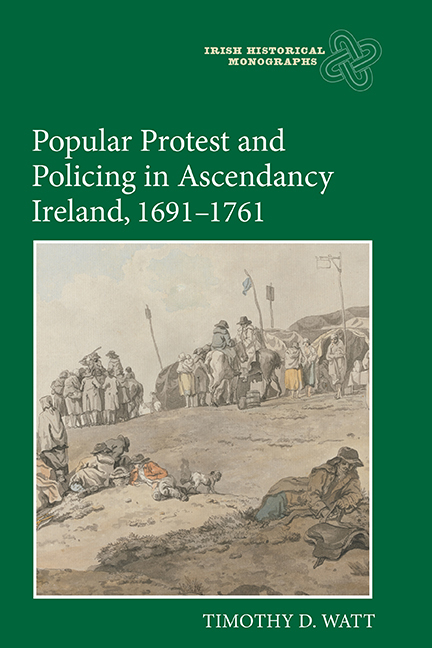Book contents
- Frontmatter
- Dedication
- Contents
- List of illustrations
- Acknowledgements
- Principal abbreviations
- Notes on conventions
- Glossary
- Introduction
- Part One Policing and large-scale disorder
- Part Two Popular Protest and Collective Action
- 4 ‘Mobs’, Authorities and Popular Politics
- 5 A ‘Rebellious Traditional Culture’ in Ireland
- 6 ‘Riot and Rescue’ and Anti-Taxation Protest
- 7 Journeymen, Masters and ‘Collective Bargaining by Riot’ in Dublin
- 8 Factional Gangs, Authorities and Corruption of the Law in Dublin
- 9 Conclusion
- Appendix: Irish Combination Acts, 1705–80
- Bibliography
- Index
- Irish Historical Monographs previous volumes
6 - ‘Riot and Rescue’ and Anti-Taxation Protest
from Part Two - Popular Protest and Collective Action
Published online by Cambridge University Press: 12 October 2019
- Frontmatter
- Dedication
- Contents
- List of illustrations
- Acknowledgements
- Principal abbreviations
- Notes on conventions
- Glossary
- Introduction
- Part One Policing and large-scale disorder
- Part Two Popular Protest and Collective Action
- 4 ‘Mobs’, Authorities and Popular Politics
- 5 A ‘Rebellious Traditional Culture’ in Ireland
- 6 ‘Riot and Rescue’ and Anti-Taxation Protest
- 7 Journeymen, Masters and ‘Collective Bargaining by Riot’ in Dublin
- 8 Factional Gangs, Authorities and Corruption of the Law in Dublin
- 9 Conclusion
- Appendix: Irish Combination Acts, 1705–80
- Bibliography
- Index
- Irish Historical Monographs previous volumes
Summary
1715, the Irish exchequer found itself in a quagmire of financial indebtedness. The Irish government's funding of a substantial part of the British military establishment, which accounted for the large majority of the exchequer's expenditure, had put a considerable strain on its finances, a situation made worse by falling revenues over the previous decade and the outbreak of rebellion in Great Britain. The annual cost of the army in Ireland between 1692 and 1735 fluctuated from a low of around £250,000 p.a. in 1702 to a peak of around £400,000 p.a. in 1728, and the proportion of spending on the military remained consistently high, at more than four fifths of the government's total expenditure. But the Irish parliament, which had the power to impose additional duties and taxes in Ireland, remained firm in its backing for the government. In particular, it gave its full support to the decision of the Irish government in January 1716 to raise thirteen new army regiments in Ireland, which would replace the regiments that had been sent to Great Britain following the Jacobite rising. Parliament declared to the king, ‘whatever forces his majesty shall think fit to raise, or whatever expense his majesty shall think necessary for the defence of this kingdom, this House will enable his majesty to make good the same’. In this way, the Irish parliament remained fully wedded to the British military establishment in a peculiarly Irish form of what John Brewer has referred to as the ‘fiscal-military state’, whereby substantial financial resources were used to fund British global ambition and to secure the authority of the government within Ireland.
The Irish parliament had to increase income flow in order to pay for this added expenditure, and measures were therefore put in place to improve the system of revenue collection and to increase taxes. Furthermore, the government arranged in 1716 for any shortfall in its income to be paid for with money borrowed from a number of private Irish creditors, initiating what was to become a permanent national debt. The combination of these measures appeared to make an immediate impact on the state of Irish public finances. The government successfully raised £50,000 through the public loan, and the yield from additional duties increased substantially, from around £85,000 in 1714 to an average annual total of approximately £240,000 in the 1770s.
- Type
- Chapter
- Information
- Popular Protest and Policing in Ascendancy Ireland, 1691-1761 , pp. 129 - 156Publisher: Boydell & BrewerPrint publication year: 2018



